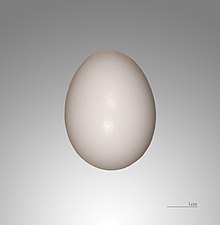Stock dove
| Stock dove | ||||||||||
|---|---|---|---|---|---|---|---|---|---|---|

Stock dove ( Columba oenas ) |
||||||||||
| Systematics | ||||||||||
|
||||||||||
| Scientific name | ||||||||||
| Columba oenas | ||||||||||
| Linnaeus , 1758 |
The stock dove ( Columba oenas ) is a species of bird from the family of pigeons (Columbidae). It is one of the five types of pigeons that occur in Central Europe.
description
The stock dove has a body length of 28–32 cm, a wingspan of 60–66 cm. The stock pigeon is about the size of the city pigeon and significantly smaller than a wood pigeon . Males weigh around 300 g on average, females around 270 g.
The plumage is blue-gray, without white plumage on the rump or wings. The sides of the neck are glossy green and the chest pale orange. The wings of the stock dove are broadly edged with black. The eyes are black. Males and females have the same coloration. The call sounds like “hu ru”.
distribution and habitat
The stock dove occurs from Europe to western Siberia as well as Asia Minor and North Africa.
From February to November the stock dove can be seen in forests and parks in almost all of Europe (except Iceland and northern Scandinavia ). It is dependent on old wood and is closely tied to the occurrence of the black woodpecker because of the nesting holes . Stock pigeons are migratory birds and migrate to western and southern Europe in winter . According to the IUCN, the entire stock of the stock pigeon is considered stable and safe.
nutrition
The stock dove feeds on fruits , seeds , berries , acorns and parts of plants. It looks for its food in fields and other green spaces.
Reproduction
The breeding season extends from March to September. The courtship is initiated by the male by bowing. Mating is preceded by beaks and feathers. The female lays two eggs in a tree cave (mostly old caves of the black woodpecker ), which is covered with stalks , sticks and leaves. Correspondingly large nesting boxes are also accepted. Males and females share the brooding and care of the young. The breeding season is 16 to 17 days.
supporting documents
literature
- David Gibbs, Eustace Barnes and John Cox: Pigeons and Doves - A Guide to the Pigeons and Doves of the World . Pica Press, Sussex 2001, ISBN 90-74345-26-3 .
- Alois Münst and Josef Wolters: Pigeons - The types of wild pigeons. 2nd expanded and revised edition, Verlag Karin Wolters, Bottrop 1999, ISBN 3-9801504-9-6 .
- Gerhard Rösler: The wild pigeons of the earth - free living, keeping and breeding . M. & H. Schaper Verlag, Alfeld-Hannover 1996, ISBN 3-7944-0184-0 .
Web links
- Columba oenas in the endangered Red List species the IUCN 2008. Posted by: BirdLife International, 2008. Accessed January 9 of 2009.
- Videos, photos and sound recordings of Columba oenas in the Internet Bird Collection
- Entry at the Swiss Ornithological Institute
- Age and gender characteristics (PDF; 6.7 MB) by J. Blasco-Zumeta and G.-M. Heinze (Eng.)
- Feathers of the stock dove
Individual evidence
- ↑ Münst, p 152

